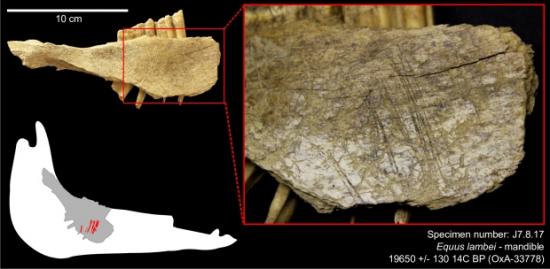Carbon dating of archeological site suggests humans were in Yukon 10,000 years earlier than previously thought
Source - http://www.cbc.ca/news/canada/north/yukon-first-humans-north-america-1.3936886
 Animal bone fragments recovered at the Bluefish Caves site near Old Crow, Yukon, appear to show signs of human tools. (Lauriane Bourgeon/University of Montreal)
Animal bone fragments recovered at the Bluefish Caves site near Old Crow, Yukon, appear to show signs of human tools. (Lauriane Bourgeon/University of Montreal)
Humans may have been living in Yukon's Bluefish Caves 10,000 years earlier than previously thought, new research from the University of Montreal suggests.
If confirmed, this would make it the oldest known archeological site in North America, representing the earliest evidence found so far of humans in North America.
New carbon aging tests were done on bones first discovered in the caves south of Old Crow, Yukon, in the 1970s.
The Bluefish Caves in Yukon lie in a region known as Beringia that stretched from the Mackenzie River in N.W.T. to Siberia nearly 24,000 years ago during the last ice age. Parts of it are now underwater.
The testing suggests that's when the human beings lived near the caves.
"We have lots of lines of evidence that are converging on what looks like quite a coherent story of what looks like human presence," said Ariane Burke, an anthropologist at the University of Montreal.
Twenty-three fragments studied by Lauriane Bourgeon "definitely" show signs of being cut by human tools, Burke said. The bones likely belong to animals butchered by the people living in the caves.
"You look at the shape the tool makes when it cuts into the bone," she said. "A stone tool will typically leave a 'V' shaped mark and that is straight with streaks on the walls of the cut mark."
Most early presence sites are dated to 14,000 years ago, the time most archeologists think humans first came to North America. It's an accepted theory because those sites have tools or charcoal present.
When the caves were first studied in the 1970s and 80s, the suggestion that humans had occupied the caves so much earlier was controversial in the scientific community as some questioned the integrity of the site and whether the animal bones found had actually been modified by humans.
 This specimen dates nearly 19,000 years ago and shows marks of being cut by a stone tool used by humans. (Lauriane Bourgeon/University of Montreal)
This specimen dates nearly 19,000 years ago and shows marks of being cut by a stone tool used by humans. (Lauriane Bourgeon/University of Montreal)
Since tools or charcoal have not yet been found at the Bluefish Caves site, some archeologists may still not accept these new findings, said Greg Hare, an archeologist with the Yukon government.
"There are still going to be a lot of archeologists who look at it with raised eyebrows," he said.
"Is it the final chapter? I don't think so. But it's good, solid work and I'm excited they've been able to revisit it and come up with those dates."
Study supports standstill theory
Aside from determining the age of the bones, the research examines the standstill theory.
That theory argues a group of humans from Central Asia were isolated in Beringia during the last ice age, 24,000 years ago. Burke says their isolation caused their DNA to become unique, and that type of DNA can be traced in humans today.
Burke says there was also pollen discovered in the caves, and it was dated to be from 24,000 years ago.
Earliest Human Presence in North America Dated to the Last Glacial Maximum: New Radiocarbon Dates from Bluefish Caves, Canada
http://journals.plos.org/plosone/article?id=10.1371/journal.pone.0169486